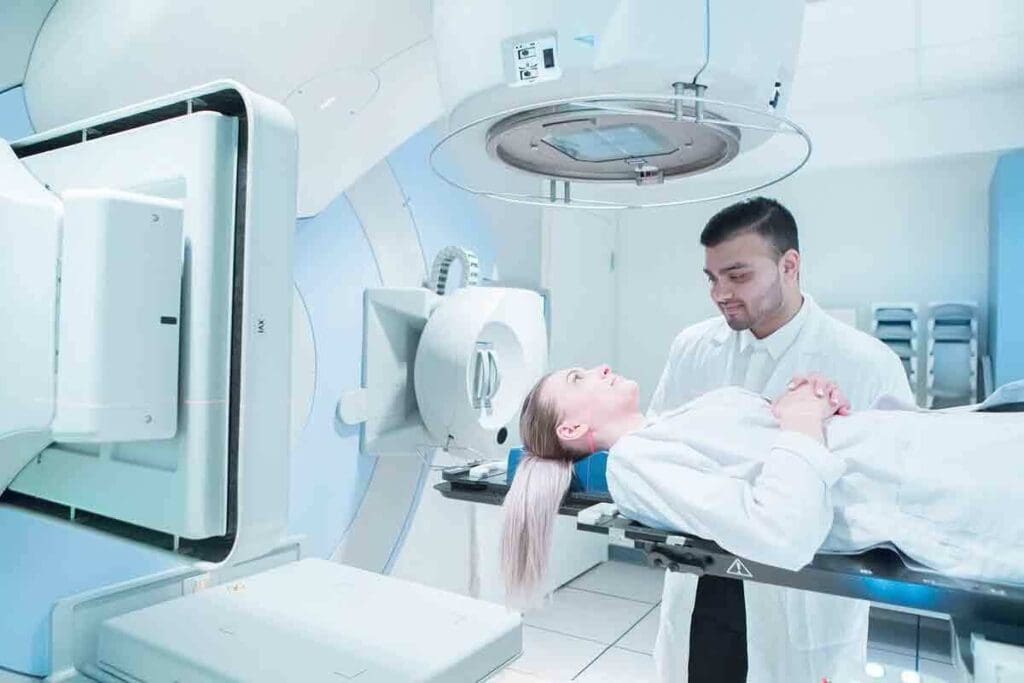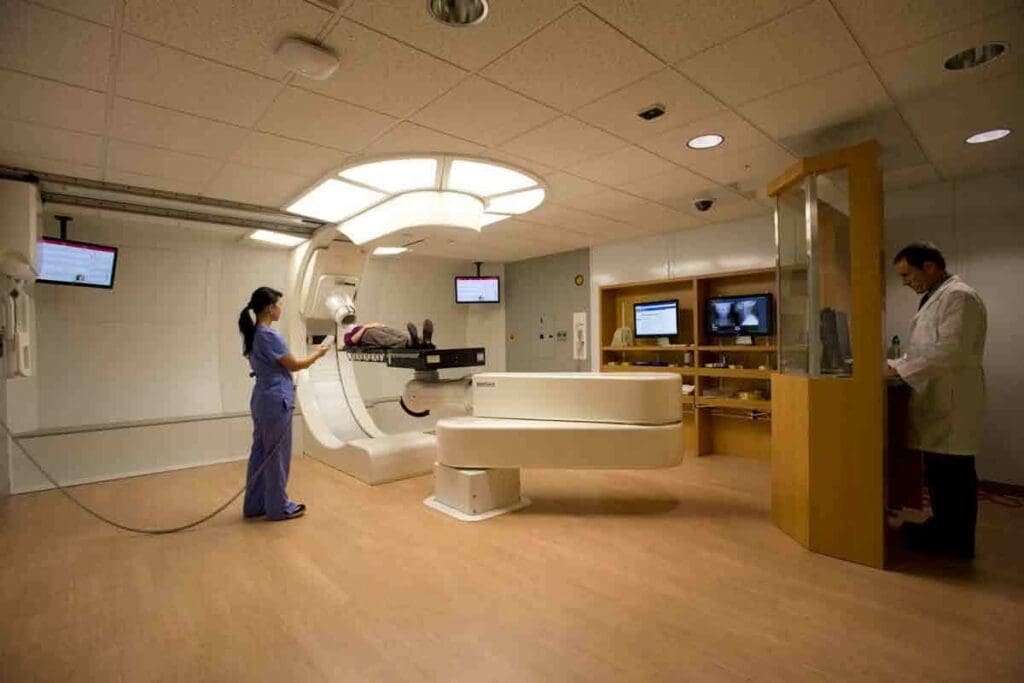Last Updated on November 27, 2025 by Bilal Hasdemir

Cancer treatment has made big strides with linear accelerator radiation therapy. This tech uses linac machines to send high-energy X-rays or electrons. These beams fit the tumor’s shape closely, protecting healthy tissue.
At Liv Hospital, we blend innovation with care for our patients. We use the latest linac radiotherapy to ensure top-notch results. Our facilities are equipped with cutting-edge tech, giving our patients the best treatment.
Key Takeaways
- Linear accelerator radiation therapy is a precise cancer treatment method.
- Linac machines deliver high-energy X-rays or electrons to tumors.
- Liv Hospital uses modern linac technology for effective treatment.
- Patient-focused care is a priority in our cancer treatment programs.
- Advanced linac radiotherapy minimizes damage to healthy tissue.
Understanding Linear Accelerator Radiation Therapy

Linac radiation oncology uses advanced technology for targeted treatments. This improves outcomes for many cancer types. We create custom plans with tools like intensity-modulated radiation therapy (IMRT) and real-time imaging.
The Role of Linacs in Modern Cancer Treatment
Linear accelerators are key in today’s cancer treatment. They offer precise and effective solutions for many tumors. We tailor radiation therapy to each patient’s needs for the best results.
Linac technology is versatile, treating a wide range of cancers. Techniques like IMRT help shape the radiation dose to fit the tumor. This reduces harm to healthy tissue.
Basic Principles of Radiation Therapy
Radiation therapy kills or damages cancer cells with high-energy particles or waves. Linear accelerators create these beams aimed at tumors.
The goal of linac radiation oncology is to hit the tumor hard while protecting healthy tissue. This is done with precise beam targeting and shaping, thanks to advanced linac tech.
Understanding linear accelerators and their role in radiation therapy shows the complexity of cancer treatment today. Our dedication to the latest linac technology ensures our patients get the best care.
The Science Behind Linac Machines

Linac machines play a key role in cancer treatment. They deliver precise radiation therapy. It’s important to understand how they work.
Core Components of Medical Linear Accelerators
Linac machines have several important parts. The waveguide is key. It uses radiofrequency waves to accelerate electrons to almost the speed of light. This is how they make the high-energy beams for treatment.
The gantry is another essential part. It lets the Linac move around the patient. This way, it can send radiation from different angles. This helps doctors target the tumor better and protect healthy tissue.
How Linear Accelerators Generate Therapeutic Radiation
When electrons hit a tungsten target, they create high-energy X-rays. This is called bremsstrahlung radiation. The X-rays’ energy can be changed to fit the tumor’s location and depth.
Linac machines also have advanced features. Intensity-Modulated Radiation Therapy (IMRT) and real-time imaging improve treatment accuracy. IMRT lets doctors adjust the beam’s intensity. This helps give more radiation to the tumor while protecting other areas.
| Component | Function |
| Waveguide | Accelerates electrons to near the speed of light |
| Gantry | Allows rotation around the patient for multi-angle radiation delivery |
| Tungsten Target | Produces high-energy X-rays when hit by accelerated electrons |
Key Fact #1: Precision Targeting in Tumor Treatment
Precision targeting is key in linear accelerator radiotherapy. It allows for effective tumor treatment while protecting healthy tissue. We use advanced technology to deliver radiation with exact accuracy, matching the tumor’s shape.
Conforming Radiation to Complex Tumor Shapes
Linear accelerator radiation therapy uses high-energy X-rays or electrons. These are shaped to fit the tumor’s exact shape. This is done with multi-leaf collimators, which also reduce radiation leakage for accurate treatment.
Being able to shape radiation for complex tumors is very important. It helps treat tumors that are irregularly shaped or near important structures. Our linac machines have advanced imaging. This lets us see the tumor in real-time for precise targeting.
Techniques for Minimizing Damage to Healthy Tissue
To protect healthy tissue, we use several techniques:
- Intensity-Modulated Radiation Therapy (IMRT): This method changes the radiation beam’s intensity to fit the tumor’s shape.
- Image-Guided Radiation Therapy (IGRT): IGRT uses imaging to check the tumor’s position before and during treatment for accurate targeting.
- Multi-leaf Collimation: As mentioned earlier, multi-leaf collimators shape the radiation beam to match the tumor’s shape, reducing exposure to surrounding healthy tissue.
By using these techniques together, we can target tumors precisely while protecting healthy tissue. This improves treatment results and enhances our patients’ quality of life.
Key Fact #2: Types of Radiation Delivered by Linac Machines
Linac machines are key in radiation therapy, delivering two main types of radiation. This makes them essential for treating different cancers. We use Linac technology to create treatment plans that fit each patient’s needs.
Photon (X-ray) Therapy Applications
Photon therapy, or X-ray therapy, is a common use of Linac machines. High-energy X-rays target deep tumors, helping treat many cancers. Adjusting the X-ray energy helps focus on tumors, protecting healthy tissue.
Experts say, “Photon therapy has changed how we treat complex tumors.” This precision is a big step forward in radiation oncology.
Electron Beam Therapy for Surface Tumors
Electron beam therapy is great for tumors near the skin’s surface. Electron beams have a limited range, perfect for treating surface lesions without harming deeper tissues.
We often use it for skin cancers or superficial lymphomas. Its ability to control depth makes it a valuable option.
Linac machines’ ability to deliver both photon and electron therapies is vital in radiation oncology. By choosing the right radiation, we can greatly improve patient outcomes.
Key Fact #3: Advanced Linear Accelerator Radiation Therapy Techniques
New technologies like IMRT and IGRT have changed radiation therapy. They make treatments more precise and effective. This leads to better care for patients and fewer side effects.
Intensity-Modulated Radiation Therapy (IMRT)
Intensity-Modulated Radiation Therapy (IMRT) changes the radiation beam’s intensity. It shapes the beam to fit the tumor. This method delivers more radiation to the tumor and less to healthy tissues.
IMRT is great for complex tumors near important areas. It uses many small beams with different intensities. This creates a dose that closely matches the tumor’s shape.
“IMRT has revolutionized the field of radiation oncology by providing a highly precise and flexible treatment modality.”
Image-Guided Radiation Therapy (IGRT)
Image-Guided Radiation Therapy (IGRT) makes radiation therapy more accurate. It uses X-ray, CT, or MRI to see the tumor and surrounding areas in real-time. This helps doctors adjust the treatment beam as needed.
IGRT is key for tumors that move, like those in the lung or prostate. It ensures the treatment is accurate, even when the tumor changes position.
| Technique | Description | Benefits |
| IMRT | Modulates radiation intensity to conform to the tumor shape | Higher doses to the tumor, reduced exposure to healthy tissues |
| IGRT | Uses real-time imaging to guide treatment | Improved accuracy, accounts for tumor movement |
IMRT and IGRT with linear accelerator technology are big steps forward. They have made treatments better, reduced side effects, and improved patient care.
Key Fact #4: The Treatment Team and Quality Assurance
A team of experts works together to make sure Linac radiation therapy is safe and effective. This team is key to hitting the tumor with precision while keeping healthy tissues safe.
Multidisciplinary Experts in Linac Radiation Oncology
Our team in Linac radiation oncology includes many medical professionals. Radiation oncologists figure out the right dose and how to deliver it. Medical physicists check that the Linac machine works correctly and that the treatment plan is followed.
Radiation therapists run the Linac machine and give the treatment. Nurses help patients with care and support, handling any side effects. This teamwork makes sure patients get care that fits their needs.
Safety Protocols and Quality Control Measures
We have strict safety rules and quality checks for Linac radiation therapy. This includes regular checks on the Linac machine and training for the team.
Our quality assurance steps are:
- Regular checks on the Linac machine’s performance and accuracy
- Verification of treatment plans before delivery
- Continuous monitoring of patient response to treatment
- Ongoing education and training for the treatment team
Following these strict rules helps us avoid mistakes. This way, we make sure our patients get the best care. Our use of advanced tech and focus on patients leads to the best results in Linac radiation therapy.
Key Fact #5: The Patient Experience During Linac Treatment
We know how important the patient experience is during Linac treatment. It affects how well the treatment works and how the patient feels. So, we focus on both the technical side and supporting our patients every step of the way.
Treatment Planning and Preparation
The first step in Linac treatment is careful planning and preparation. Advanced imaging technologies like CT scans and MRI help us find the tumor and understand its size. This helps us create a treatment plan that targets the tumor well but also protects healthy tissues.
During planning, patients go through a simulation. This is when we figure out how they should be positioned for treatment. Our team is there to explain everything and answer any questions patients might have.
- Customized immobilization devices help patients stay in the right position during treatment.
- Treatment planning software helps us plan the radiation beams and the best dose for the tumor.
What to Expect During Treatment Sessions
When it’s time for treatment, patients meet our friendly staff. The treatment itself is short, usually just a few minutes. The Linac machine sends targeted radiation to the tumor site during this time.
Our team watches patients closely during treatment. They use cameras and imaging systems to make any needed adjustments. We know this can be scary for some, so we’re here to support and reassure them.
- Patients lie on the treatment couch as marked before.
- The Linac machine is set to the right angle and position.
- The machine moves around the patient to hit the tumor from different angles.
Throughout treatment, patients see their radiation oncologist regularly. This is to check on their progress and any side effects. We aim to give the best care possible, focusing on both how well the treatment works and how comfortable it is for the patient.
Key Fact #6: Breakthrough MR-LINAC Technology
Advanced radiation therapy has made a big leap with MR-LINAC technology. This new tech combines MRI imaging with Linacs’ treatment abilities. It’s changing how we treat cancer.
Integration of MRI with Linear Accelerators
MR-LINAC combines MRI with Linacs for MRI-guided radiation therapy. This lets us see tumors in real-time during treatment. We can then adjust the treatment plan to hit the tumor right on.
MR-LINAC is better than the old ways of treating cancer. It’s more precise, safer for healthy tissues, and boosts patient results. Its real-time imaging is key for tumors that move, like those in the belly or chest.
Adaptive Therapy for Moving Targets
MR-LINAC is great for treating tumors that move. Tumors that move with breathing or body actions are hard to hit with old radiation. MR-LINAC tracks the tumor’s movement and adjusts the beam. This makes sure the tumor gets the right dose without harming nearby tissues.
| Feature | Traditional Linac | MR-LINAC |
| Imaging during Treatment | Limited to X-ray imaging | Real-time MRI imaging |
| Tumor Tracking | Indirect methods | Direct visualization |
| Adaptive Therapy | Not available | Enabled |
The table shows how MR-LINAC is different from old Linac tech. Its advanced imaging and ability to adapt are big steps forward. They mean better treatment for patients with tricky or moving tumors.
As we keep improving in radiation oncology, MR-LINAC is key. We’re dedicated to using these new tools to give our patients the best care.
Key Fact #7: Global Impact and Future Developments
The future of cancer treatment is being shaped by Linac technology. This technology is growing globally and playing a key role in cancer care. We see significant growth in the global market for medical Linacs.
Market Growth and Access to Linac Technology
The global market for medical Linacs is expected to reach about 4 billion USD by 2025. This growth is driven by the demand for advanced radiation therapy technologies. Not just in developed countries, but also in emerging economies, Linac technology is being invested in to improve cancer treatment.
More people now have access to Linac technology, which was once scarce in many areas. This is important for providing quality cancer care to more people worldwide.
Global Market Trends:
- Increasing adoption in emerging economies
- Rising demand for advanced radiation therapy
- Technological advancements are driving market growth
Emerging Innovations in Linear Accelerator Design
Linac technology is always evolving, with new innovations coming up. One big development is MR-LINAC technology, which combines MRI with Linac systems.
Other trends include:
- Improved beam delivery systems
- Advanced imaging capabilities
- Enhanced patient comfort features
| Innovation | Description | Potential Impact |
| MR-LINAC Technology | Integration of MRI with Linac systems | Real-time imaging during treatment |
| Advanced Beam Delivery | Improved precision in radiation delivery | Enhanced tumor targeting |
| Patient Comfort Features | Design improvements for better patient experience | Reduced anxiety and improved treatment outcomes |
Looking ahead, Linac technology will remain vital in cancer treatment. With ongoing advancements and more global access, we’re hopeful for better patient outcomes. This will have a big impact on cancer care worldwide.
Conclusion: The Evolving Landscape of Linac Technology in Cancer Care
Linac technology is getting better, making cancer treatment more precise and effective. New tools like AI and MR-LINAC are key to this progress. These advancements allow for real-time imaging and adaptive therapy, which is a big step forward.
Studies have shown that MR-LINAC technology can reduce side effects in prostate cancer patients. The MIRAGE trial found less damage to the bladder and bowel. Another review found that MR-LINAC caused fewer severe side effects than traditional methods.
More research is underway to see how MRI-guided therapy can help prostate cancer patients. This includes trials like EXCALIBUR and SHORTER. These studies aim to improve treatment results and patient care.
FAQ
What is a linear accelerator used for in cancer treatment?
A linear accelerator, or linac, helps treat cancer patients. It sends radiation to kill cancer cells and shrink tumors.
How do linear accelerators work?
They speed up electrons to high energies. Then, they produce X-rays or electron beams to target tumors.
What is the difference between photon therapy and electron beam therapy?
Photon therapy treats deeper tumors. Electron beam therapy is for surface tumors or those near the skin.
What is IMRT, and how does it enhance linac treatment?
IMRT shapes the radiation beam to fit the tumor. This reduces harm to healthy tissue.
What is IGRT and its role in linac radiation therapy?
IGRT uses imaging to guide radiation therapy. It ensures the tumor is accurately targeted.
What is MR-LINAC technology and its benefits?
MR-LINAC combines MRI with linear accelerators. It offers real-time imaging and adaptive therapy for moving targets.
How is the patient experience during linac treatment?
Patients prepare for treatment before sessions. Sessions are painless and non-invasive, with the team monitoring progress.
What kind of team is involved in linac radiation oncology?
Experts like radiation oncologists, medical physicists, and therapists work together. They ensure safe and effective treatments.
What safety protocols are in place for linac radiation therapy?
Strict safety protocols and quality control measures are followed. They minimize risks of radiation exposure.
What are the future developments in linac technology?
New advancements in MR-LINAC technology are expected. They will improve treatment precision and effectiveness, benefiting cancer care.
Reference:
Ocanto, A., Torres, L., Montijano, M., Rincón, D., Fernández, C., Sevilla, B., Gonsalves, D., Teja, M., Guijarro, M., Glaría, L., Hernánz, R., Couñago, F., Zafra-Martin, J., Sanmamed, N., Kishan, A., Alongi, F., Moghanaki, D., & Nagar, H. (2024). MR-LINAC, a new partner in radiation oncology: Current landscape. Cancers (Basel), 16(2), 270.






